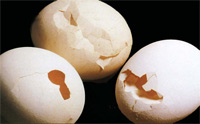
Gross cracks

Description
The term ‘gross cracks’ refers to large cracks and holes, which usually result in a broken shell membrane.
Incidence
The incidence of gross cracks increases with the age of the hen. It ranges from 1 to 5% of total production.
| Cause | Control |
|---|---|
| Reduced shell strength due to: | |
| Ageing | Keep flock age as low as economically possible. |
| Poor nutrition | Make sure that the birds’ nutrient intake is correct (particularly regarding calcium and vitamin D3). Mixed feed should be handled carefully so that the different components do not separate out. This particularly needs to be checked when augers and automatic feeding systems are used. |
| Saline water | Desalinate, dilute or do not use drinking water containing problem levels of salts. |
| Diseases such as infectious bronchitis | Follow an effective vaccination programme. |
| High shed temperatures | Control temperatures by using foggers, fans, roof sprinklers, white roofs, insulation and good ventilation. |
| Mechanical damage caused by birds’ beaks and toenails | Control egg eating by the birds. Make sure that birds do not have access to eggs in roll-out trays. Use cages designed to prevent access. Reduce damage caused by the birds’ toenails. The slope and construction of the cage fl oor should allow the eggs to move freely to the roll-out tray. |
| Infrequent egg collection | Collect eggs at least twice a day. |
| Rough handling | Do not collect eggs in wire baskets. When stacking
fi llers of eggs, place one empty fi ller at the bottom of
the stack, and a full one directly on top of it. This double
bottom layer supports the weight of the stack better.
Avoid stacking fillers of eggs more than six high. Pick
up and carry stacks with care. Place large eggs on top
fi llers in a stack. Reduce the severity of impacts during
mechanical handling by: • cushioning metal egg guides; • keeping egg roll-out angles between 7 and 8°; • minimising the number of rows of eggs being fed onto cross-conveyor belts at any one time. Educate staff to handle eggs with care during collection and packing. |
COPYRIGHT NOTICE: OPTIMUM EGG QUALITY - A PRACTICAL APPROACH
© The State of Queensland, Australia (through its Department of Primary Industries and Fisheries) and DSM Nutritional Products Ltd., 2007. No part of this publication may be reproduced, copied or transmitted save with prior written permission of Director, Intellectual Property Commercialisation Unit, Department of Primary Industries and Fisheries, GPO Box 46 Brisbane, Queensland, Australia 4001, and DSM Nutritional Products Ltd.
© The State of Queensland, Australia (through its Department of Primary Industries and Fisheries) and DSM Nutritional Products Ltd., 2007. No part of this publication may be reproduced, copied or transmitted save with prior written permission of Director, Intellectual Property Commercialisation Unit, Department of Primary Industries and Fisheries, GPO Box 46 Brisbane, Queensland, Australia 4001, and DSM Nutritional Products Ltd.






